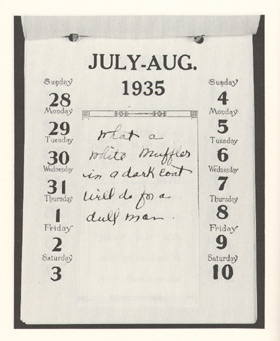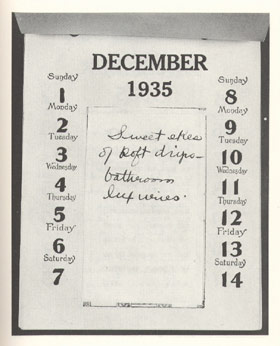Lorine
Niedecker:
"Next
Year or I Fly My Rounds, Tempestuous."
EDITOR'S NOTE / Published in Sulfur 41 (Fall 1997)
Lorine Niedecker's "Next Year or I fly my rounds, Tempestuous" surfaced during my recent probing of the Louis Zukofsky Collection at the Harry Ransom Humanities Research Center, Austin, Texas. The poem was filed with miscellaneous items of unidentified authorship. It is handwritten on small pieces of paper pasted into a 27-page pocket calendar, 4½ x 3¾", two weeks per page, the hole-punched pages held together by a red velvet ribbon tied in a bow. Niedecker's pastings obscure "The Favorite Sunlit Road Calendar's" own text, platitudes such as these-January 13-26: "True bravery is/shown by performing/without witness what/one might be capable/of doing before all the/world"; Sept. 22-Oct. 5: "To reach the port/of heaven, we must/sometimes sail with/the wind and some-/times against it-but/we must sail and not/drift, nor lie at anchor." The original text is just legible when held to the light. Her spirited title inverts rather than pastes over the calendar's title page. The poem makes no explicit reference to the pasted-over homilies but the aleatoric nature of the palimpsest exudes parody.
Given that the poem was held by Zukofsky and given his dating on the back of the calendar-"Xmas 1934"-the poem was likely Niedecker's gift to the poet whom she had now known in person for a full calendar year. The gift looks forward confidently to another year of friendship just as it recalls the past year. A pocket calendar, an intimate mnemonics. But the poem is also a surrealist composition and an experiment in form. The calendar itself is under siege. She teases the mnemonic device by linking her non-sequitur and baffling lines to the predictable chronology of a calendar. Earlier in 1934 she had written to Harriet Monroe about her desire to "discredit all journal method everywhere...." The same letter also talks of adding a section to "Year Before Last" and of composing a piece called "Year After Next." (Neither of these works has survived.) Her challenge to the calendar-earlier poems had challenged the dictionary-apparently extended to include "Next Year or I fly my rounds, Tempestuous."
Zukofsky showed the poem to his friends: in January 1936, he wrote to Niedecker about William Carlos Williams' enthusiasm for the form of "last year's Xmas calendar" and his interest in seeing it published. Like some of her other surrealism, this poem posed obvious difficulties for publication. She was, however, always keen to see her work in print, and any misgivings one might have about publishing an apparently private gift must contend with the ambition of her enterprise. While much of the poem is written in the first person, in lines that appear to be addressed to Zukofsky-"Don't worry/about the comma,/darling"-the sleuthing reader is seldom rewarded. Privacy remains secure.
The poem is a free and delighted collaboration of cogency and chance. It is assured, worldly, funny, at ease with its liberties. There are echoes of Dickinson, Zukofsky, and Niedecker's subsequent writings. And it is closest in style to the two surrealist plays-"President of the Holding Company" and "Fancy Another Day Gone"-that were still to follow.
"Next Year or I fly my rounds, Tempestuous" is the second recent discovery of a 'lost' Niedecker poem. In 1995, Burton Hatlen found the five-page, eight-part poem, "Progression," in the Ezra Pound papers at the Beinecke Library. "Progression" is dated January 6, 1934 although, according to a letter to Harriet Monroe, a version of the poem was already complete by mid-1932. "Next Year or I fly my rounds, Tempestuous" adds to the growing record of Niedecker's early career.
—Jenny Penberthy

